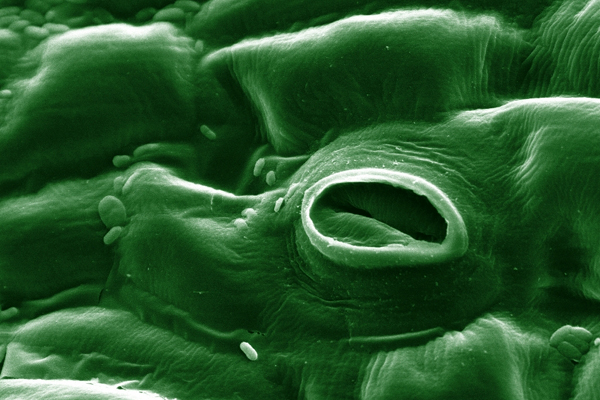Stomata

Stomata (singular: stoma) are tiny pores found mostly on the underside of plant leaves. You can think of them as little breathing holes that help plants survive by controlling gas exchange and water loss. Each stoma is controlled by two guard cells that open and close the pore depending on the plant’s needs and the environment.
Here’s what stomata do: Let carbon dioxide (CO2) into the leaf for photosynthesis, the process plants use to make their food.
Release oxygen (O2) as a byproduct of that process.
Control the release of water vapor in a process called transpiration.
But in the Mojave Desert, where water is hard to come by, plants have developed special ways to use stomata to survive the heat and dryness:
Fewer stomata – Desert plants often have fewer stomata to limit how much water escapes.
Sunken stomata – Some stomata are set deep into the leaf or tucked in grooves to protect them from wind and heat, which reduces water loss.
Open only at night – Many desert plants, like cacti, agaves, and Joshua trees, use a process called CAM photosynthesis. They open their stomata at night to take in CO2 when it's cooler and less water will evaporate. Then, during the day, they close the stomata and use the stored CO2 for photosynthesis.
Thick leaves or waxy coatings – These features help trap moisture, so the stomata don’t have to open as much or as often.
Examples:
Creosote bush has tiny, waxy leaves with very few stomata—perfect for saving water.
Beavertail cactus opens its stomata at night and keeps them protected during the day.
Mojave yucca also uses CAM photosynthesis and has tough, narrow leaves to reduce moisture loss.
In short, stomata are essential for plant life, but desert plants have learned to use them in smart and efficient ways to survive harsh conditions. They’re like carefully controlled vents—always balancing the need for air with the need to save water.
STOMATA - Stomata are small holes on the underside of a leaf through which water is transpired. On needle-bearing trees such as spruce, pine, and fir, large rows of stomata can be seen as the white stripes on the underside and/or top of each needle.